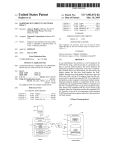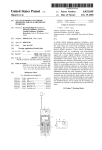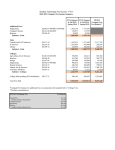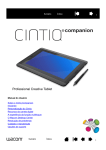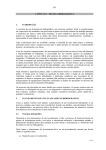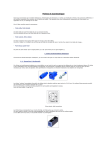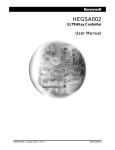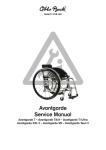Download US005`754960A
Transcript
US005‘754960A United States Patent [19] [11] Patent Number: Downs et a1. [45] [54] DISPLAY CONSOLE AND USER INTERFACE FOR TISITE RF TR D SYSTEM [75] Inventors: Stephen R_ Downsz Charles P_ Emma Date of Patent: 5,754,960 May 19, 1998 OTHER PUBLICATIONS Jones. ‘The Pye TVT Approach to Audio Controls Sys terns". International Broadcast Engineer. vol. 6. No. 122. pp. both of Forest; Satish Kappagantula. 4-6" 8'11‘ Mar" 1975; Lynchburg an of Va. Ullah. “Master Sw1tch1ng Control Panel for Broadcast Stud ies”. ABV Technical Review (Japan). No. 69 (Jul. 1980). [73] Assigmc; Ericsson Inc" Research Triangle park Motorola Coverage Guide for Smartnet'l'M System Users (70 NC page brochure and Table of Contents (pp. l-15). Trunking Console System Functional Speci?cation. Console _ Systems. Inc.. Console System Electronics Section 2 (pp. [21] Appl. No.. 835,689 2_1_2_66). [22] Filed: Motorola Centracorn Series II Plus brochure dated Jul. 1. Feb. 14, 1992 1988 (6 pages). Related US. Application Data I [63] Motorola System Planner RC-2-37C. Man. 1988. “Centra . com Series 11 Control Centers” (pp. 1-42). cmmnua?o?-in'pal‘l of Sen N0‘ 325,639,13eb- 22, 1991311 Motorola System Planner R4-—2—73A. JuL. 1990. “Centra No‘ 5’200’954‘ com Series 11 Plus Control Centers" (pp. 1-46). [51] Int. Cl.‘5 ..................................................... .. H0413 7/00 Motorola. Inc. Centracom Series 11 PlusTM CR1‘ Console [52] US. Cl. ........................ .. 455/508; 455/520; 381/123; Operator’? Manual (PP- 1—40):Ap1>911¢lix A (PP- 1—6): Glos 379/267 [58] saw (14» 1—5) Field Of Search ......................... .. 455/15. 33.1. 53.1. GB C3” Scri?s- Overview and I"'T°d“c?°“~ Standard Pm 455/541; 379/59. 63. 203. 204. 267. 142; 340/721, 712; 381/123 [56] ‘16° #2-4°°-1°°2-°1~ Jul-- 1983 (List continued on next page.) References Cited Primary Examiner—Edward F. Urban Attorney Agent, or Firm--Nixon & Vanderhye PC. US. PATENT DOCUMENTS [57] 3,611,301 10/1971 Parks .................................. .. 340/1725 3,678,391 3,809,910 7/1972 Gough ....................................... 325/55 5/1974 Walker 81 81- Cromwell .......................... n 4,386,118 8/1981 Mgggc?eet et """""""""""" " new” :1‘ a1‘ ‘ ABSTRACT A dispatcher console for use in a digitally trunked. multisite public service radio system. The dispatcher counsel oom pris6s a personal computer having a co_processor logic 3 board. an audio switching tower. and user I/Os including a Customized keyboard. display screen. audio speakers. head 4 653,090 3/1937 Haydeny........ .................... .. 379/204 4:698:805 10/1987 Sasuta et a]. ...... 370/97 4326954 2/19g3 Molnar , 56‘ and a "ansmi‘ f°°t Pedal The switching tower mums audi° c°mmunica?°ns between the °°I1S°1° and multisite 4,866,764 4,901,314 4,924,496 ...... 379/368 371/112 the oo-processor board. The customized keyboard is also connected directly to the co-processor board and has dedi 379/ 142 cated keys for commonly performed functions. The display iigg?g , , 4,947,162 4,961,070 9/1989 Barker, III 2/1990 Lohrbach .. 5/ 1990 Figa et al 52:?“ e1 21 e switch. The tower is controlled by and connected directly to screen presents information in a standard format such that .......... .. , 8/1990 Kimura . 340/825 00 _ _ $02113?“her knows prcclscly whcm to ?nd Pamcular 10/1990 Maher a a1. ......................... .. 340/721 1 °“' (List continued on next page.) 9 Claims, 9 Drawing Sheets CRT MONITOR PERSONAL 1g coupons ---------------- -» 1 ,—\' £26 3 swim CWPUYER : : KEVZQRD """"" M, E MA 1 T0 _ IIJLTIS'T ; 28 AIDCM COMM IOWER | I : _' : VOICE : 5,754,960 Page 2 US, PATENT DOCUMENTS 4,964,157 5,548,810 10/1990 Aoshima ............................... .. 379/204 8/1996 Riddell et a1. .......................... .. 455/89 OTHER PUBLICATIONS 4,972,457 11/1990 O‘Sullivan. ghl'?s ‘ 31 , , orst et 379,96 . ............................. .. GE C3TM Series Console Dispatch Center. Standard Practice _ 5,101,502 3/1992 Felderman et a1. .................. .. 455/531 #2‘403 1003-91‘ 5,113,431 5,130,662 5/1992 Hom I 7/1992 Jorgensen a; a1, , GE C3TM Senes Mamtenance and Adrmmstratlon Posltlon (MAP) User Manual. Standard Practice #2,401—1004-01. 5,159,701 10/1992 Barnes et a1. .................... .. 455/541 X 5,169,342 12/1992 Steele et a1. ...... .. 345/146 5,200,954 4/1993 TeeLJretal. Ch?dress et ....... .. 5,223,344 5,241,537 6/1993 Manseu at a], _ 342/357 8/1993 Gulliford et a1. ....................... .. 370/67 455/331 X 1988‘ , _ _ _ _ 1111.. 1988. GE Mobile Communications C31“ Series Console 16 Plus@ ‘ 0P eratorsas Manual _ ' _ _ Ericsson GE Mobile Communicatnons 16GEMS Mulusne Coordinator Maintenance Manual (LBI-38456A). US. Patent May 19, 1998 INPUT QUEUE EMPTY? Sheet 6 0f 9 YES FIG 5’ REMOVE CODE I FROM QUEUE SEND COMMANDS TO A1OCM 802 “803 l SEND CODE N804 TO PC GET OUTPUT MESSAGE ‘\806 FROM DPRAM _I___ SEND COMMANDS ~30? TO AIQCM 808 t SET TONE A509 GENERATOR 5,754,960 US. Patent May 19, 1993 Sheet 7 of 9 901 READ SCANNER CHIP SENSOR “902 MEMORY l COMPARE NEW AND OLD N903 READINGS l rmo INPUT THAT CAUSED N904 INTERRUPT l CONVERT tNPUT POSITION T0 \905 A cool; i PUT c005 INTO N906 INPUT QUEUE R513? INTERRUPT FIG 9 5,754,960 5,754,960 1 2 DISPLAY CONSOLE AND USER INTERFACE FOR MULTISITE RF TRUNKED SYSTEM speci?cally selecting the groups and individual users to participate in the call. The coverage of RF systems has been dramatically increased by linln'ng several broadcast sites in a multisite network. Multiple transmitting sites are often necessary to provide RF communications to all locations within a given community. Multiple transmitters can accommodate a rural RELATED APPLICATIONS This is a continuation-in-part of Ser. No. 825.689 ?led Feb. 22. 1991. now US Pat. No. 5.200.954. issued Apr. 6. 1993. community covering many square miles. Similarly. multiple This application is related to the following co-pending transmitters may be used in a city having many buildings that obstruct RF signals. Thus. RF systems are no longer and commonly assigned US. patent applications: US. Pat. No. 5.384.854. issued Jan 24. 1995. entitled “Co-Processor Controlled Switching Apparatus And Method For Dispatching Console” ?led contemporaneously with this con?ned to a single transmitter. The complexity of the system from the view of a dis patcher console is substantially increased by additional channels and multiple transmitters. Instead of broadcasting application. in the name of James L. Teel. In. Stephen R. Downs. and Charles G. Herndon. Application Ser. No. 07/658399 ?led Feb. 22. 1991. which is a continuation-in-part application to Ser. No. 07/573977 entitled “Distributed Multisite Coordination System” ?led on 28 Aug. 1990 in the name of James L. Teel. Jr. US. Pat. No. 5.200.954. issued Apr. 6. 1993. entitled “Protocol Between Console And RF Trunking System." US. Pat. No. 5.297.354. issued Feb. 15. 1994. entitled “Data Protocol And Monitoring System For RF Trunking Multisite Switch Global Serial Channel." US. Pat. No. 5.239.538. issued Aug. 24. 1993. entitled “Controller Architecture For RF Trunking Distributed Mul tisite Switch.” US. Pat. No. 5.392.278. issued Feb. 21. 1995. “Distrib uted Multisite Switch Architecture.” US. Pat. No. 5.384.776. issued Jan. 24. 1995. entitled over a single transmitter on a small number of channels. dispatcher consoles now broadcast over tens. hundreds or even a thousand channels distributed over several transmit ters covering a wide area or a large city. A single call can be broadcast from several sites over as many different channels. 20 Similarly. the complexity of RF systems is also increasing 25 30 35 telecommunication devices. In particular. the invention relates to a public service radio dispatcher console having a cathode ray tube (CRT) display. customized keyboard. and single system handles an entire metropolitan government. groups can be formed. disassembled and rearranged by the radio dispatcher. Voice calls can be encrypted for security. Telephone line calls can be made or received through the dispatcher console. Moreover. communications can be in the fonn of data transmission and are no longer just audio communications. Dispatchers are facing an increasingly complex RF com munications systems. This complexity increases the number of choices to be made by the dispatcher in handling com munications. Dispatchers cannot be overwhelmed by the operational aspects of the RF system. The dispatchers must other user interface devices. including the police department. ?re department. With the advent of digitally trunked multisite systems. RF members covered by different radio broadcast sites. These FIELD OF THE INVENTION area that a single system covers have increased substantially. Since more channels are available. the number of system users has increased. In the past. an individual system would have had one police station or one ?re department. Now. a for that group or individual. systems can direct calls to individuals or selected group This invention relates to user interfaces for computerized INVENTION Radio dispatchers work with radio communication sys tems that are becoming increasingly complex. The number of radio frequency (RF) channels in these systems and the become available for these systems. Previously. RF systems had basic key and unkey call terminate functions. In were made by selecting the appropriate dedicated channel incorporated by reference. BACKGROUND AND SUMMARY OF THE because of numerous additional operation features that have untrunked systems. calls to selected individuals and groups “Audio Routing With ATrunked Radio Frequency Multisite Switc ." The disclosure of each of these related applications is ‘The dispatcher console must now be informed of the indi vidual transmitters and channels that are being used. and of the status of other transmitters and receivers in the system. 45 be free to concentrate on the substance of the calls. any one of which may be an emergency call. The added features of a complex RF could become a hinderance to the dispatcher. unless the dispatcher is able to quickly and easily operate the dispatch console. Past dispatcher consoles have not been St] particularly user friendly. In the prior art. US. Pat. No. 4.961.070 discloses a “Radio Console With CRT Display” that allows channel control windows (CCW). representing selected radio channels. to be moved about the display. The CCWs present status infor 55 mation on individual sub?eet communication. such as sub ambulances. hospitals, and other governmental services. ?eet identi?cation. caller id and whether the call is busy. The CCWs are moved about the display using a computer-mouse Instead of only communicating with a small number of interface which also allows the user to operate a menu at the users. radio dispatchers can now communicate with bottom of the display screen. It is believed that this patent discloses the Motorola Centracom 11 Plus dispatcher con sole. Another prior art dispatcher console is the Console Dis hundreds. if not thousands. of system users. These system users. e.g. mobile radio units. hand-held radios. other consoles and conventional radio base stations. are usually grouped by function into agencies. ?eets. and groups. The dispatcher has the ability to communicate with patch Center for the C3TM Series Consoles sold by the assignee Ericsson GE Mobile Communications Inc. The individual users or these functional groups. In addition. the 65 C31‘M Console is a microprocessor controlled voice switch dispatcher can patch users and groups together for a speci?c ing system. The dispatcher workstation includes a control call. Similarly. the dispatcher can set up a sirnulselect call by panel of dials. buttons and small displays corresponding to 5 ,754.960 3 4 individual call groups. consoles and other units. Both of PC computer equipped with VGA graphics. 2 megabytes of these prior art systems present the dispatcher with compli cated and non-uniformly displayed information. The computer uses a proprietary (VRI'X) multi-tasking RAM. a hard disk and a ?oppy disk for loading software. operating system published by Ready Systems. Inc. of Sunnyvale. Calif. There is a need for dispatcher consoles that displays call information in an easy-to-comprehend manner. that can be simply con?gured to suit individual dispatchers. An inven In addition. the computer has an internal co-processor logic board 26 that is further described in U.S. Pat. No. tive dispatch console has been developed that is easy for the dispatcher to operate through a customized keyboard and CR1‘ computer display. The dispatch console includes a standard personal computer (PC) having a novel co-processor logic board; a customized keyboard connected to the co-processor board; a CRI‘; devices for audio com munications such as speakers. earphones. microphones and a push-to-talk foot pedal; and an audio switching tower for routing audio between the dispatch console and multisite switch. The CRT display screen presents information on ongoing communications throughout the RF system and historical information on recently terminated calls. The display is segmented into functional windows. These windows provide 20 5.384.854 entitled “Co-Processor Controlled Switching Apparatus and Method for Dispatching Console” and incor porated by reference above. This co-processor board per forms the audio and command routing functions necessary for the dispatcher console. The logic board allows a standard personal computer to be converted into a dispatcher console. The customized keyboard 14 is coupled to the logic board and thereby to the personal computer. A standard keyboard 25 may also be connected to the personal computer. but is not necessary for the operation of the dispatcher console. The dispatcher console 10 communicates with the RF system through a console interface module (CIM) (not shown) in a multisite switch 28. The multisite switch routes audio (voice) and data signals throughout the RF system. By information in a uniform and easy to read manner. For way of the multisite switch. the dispatcher console commu example. information on individual communications is nicates with the trunked and conventional radio systems shown in an array of communication module windows. Each coupled to the switch. to telephone lines connected to the communication module provides information on a speci?c 25 switch and to other dispatch consoles. The dispatch console call or group such as the caller. volume. and emergency. and CIM communicate using the messages and the protocols The customized keyboard has been tailored so that certain described in further detail in U.S. Pat. No. 5.200.954 entitled keys are dedicated to speci?c radio functions. For example. “Protocol Between Console and RF Trunking Switch" and dedicated keys are provided for transmit. communication module control. patch and simulselect calls. and telephone and intercom communications. Common function keys. e.g. incorporated by reference above. Individual dispatcher pro?les and entity databases are F1. F2. are assigned to control various other functions as loaded into the hard drive of the dispatcher console personal computer from the MOM-PC 30 via the console-CIM data needed and in conjunction with display menus. link to the multisite switch. The MOM-PC is a central BRIEF DESCRIPTION OF THE DRAWINGS 35 FIG. 1 is a block diagram of a dispatcher console for the present invention; FIG. 2 is a display screen for the dispatcher console Con?guration and Diagnostics Interface" and incorporated shown in FIG. 1; FIGS. 3 to 5 illustrate portions of the display screen shown in FIG. 2; FIG. 6 is a diagram of the customized keyboard shown in FIG. 1; FIG. 7 is a block diagram of the co-processor board in the personal computer shown in FIG. 1; and by reference above. The hard disk and PC-RAM in the personal computer stores the user pro?le that identi?es among other things. the dispatcher and the user groups in which the dispatcher 45 DETAIIED DESCRIPTION OF THE DRAWINGS monitor 12. a customized dispatch keyboard 14 with 101 labeled keys. audio speakers 16 (in the preferred embodi participates. The pro?le contains information regarding the preferred console settings for the particular dispatcher and initial radio settings. As each dispatcher sits down at the console. such as at the beginning of a new shift. the FIGS. 8 to 11 are software process ?owcharts showing the operation of the co-processor board illustrated in FIG. 7. FIG. 1 shows a dispatcher console 10 having a color CRT control computer for the RF system and is under the control of the system operator for the entire RF system. The operation of the MOM-PC is described in more detail in U.S. Pat. No. 5.566.388 entitled “RF Trunking Multisite Switch 50 dispatcher calls up the appropriate user pro?le tailored to that dispatcher. The dispatcher can display the user pro?le by depressing a function key on the customized keyboard. The personal computer for the console also stores a database of user entities. Each entity is an individual trunked radio unit (e.g. mobile. portable. or console). a radio talk group. or a conventional radio. There can be several thou ment each console can have two to twelve speakers). speaker volume controls 18 underneath each speaker. a microphone 55 sands of radio entities in a multisite system. Accordingly. 20 (or alternatively a headset 21 with volume control 22). and a foot switch 23 that is a push-to-talk switch. The dispatcher need look only at the CRI‘ monitor to operate the console. The dispatch keyboard provides complete control PC-RAM storage is used. instead of ROM. because the entity database may be large and changed in real-time. The entity database includes a record of each entity including the entity 1]) number. type of entity. e.g. unit and group. home site. home group and an eight character ASCII name. The console personal computer saves some database updates to hard disk immediately. and some updates are saved only on demand. Thus. the database records are loaded The speakers. microphone. headset and foot pedal are from the disk when an operator shift occurs (dispatcher connected to an audio communications tower 32. The CRT monitor 12 and an optional standard keyboard 25 are con 65 pro?le change) or at startup. 'Ihe MOM-PC database and hard disk can be used for back-up storage to the PC-RAM. nected to a conventional personal computer 24. In the If the link breaks between the MOM-PC and the console. the preferred embodiment. the personal computer is an AT-class over the console to the dispatcher. However. push-to-talk switches are provided on the microphone 20 and foot pedal 23 for the dispatcher’s convenience. 5 ,754.96() 6 5 console will still have relatively-current database informa The arrangement of these segments on the screen does not change. However. the information presented in each window segment does change. Thus. the dispatcher can become tion stored on disk. The dispatcher console relies on the MOM-PC centralized databases to update and change most of its databases. Since the personal computer is linked to the MOM-PC via the mulitsite switch. it has on-line access to these centralized familiar and comfortable with the arrangement of the seg ments on the screen. This familiarity allows the dispatcher to pick out desired information quickly from individual win databases. The MOM-PC can send an entire database. or dows because the dispatcher learns precisely where this information is displayed by knowing the location of each update information for a database such as a single entity updates to modify the entity database. New data base segment. information can be broadcast on demand by the MOM-PC operator or requested by a console. such as when the console comes back on-line after being off-line for a period of time. One window segment 40 provides a listing of available entities. e.g. site controllers. groups. units. consoles. con ventional channels and telephone lines. in the RF system. Another segment 42 of the display lists the pages of com munications modules 44 that can be shown. By segregating the communications modules into pages. the number of communication modules that can be displayed is drastically The MOM-PC operator may create multiple dispatcher user pro?les for each dispatch console. Having multiple dispatcher user pro?les allow different dispatchers. e.g. a dispatcher for each work shift. to con?gure the dispatch console to the individual requirements for each dispatcher simply by calling up the tailored user pro?le for that dispatcher. The dispatcher user pro?les are stored in the increased and the individual modules can be appropriately grouped by pages. Communications module windows 44 are arranged con veniently in columns and rows. These modules provide call access to individual groups. entities. consoles and telephone lines in the system. Each communication module is pro dispatcher console. The dispatcher user pro?les can be set up and changed only at the MOM-PC. In addition. each dispatcher console includes an audio input/output communications module (AIOCM) 32 other grammed by the dispatcher to represent a particular group. wise known as a communications tower that links the audio unit. console. channel. line. etc.. that is available to the console. To assist in programming the communications channels from the ClM of the multisite switch 28 with the 25 speakers. microphone and the foot pedal of the dispatcher module. the available groups. units. consoles. or channels console. The communications tower is an audio routing may be displayed in the listing window 40. e.g. a listing of switch for the dispatcher console. The AICOM is controlled via link 27 by the co-processor logic board 26 in the personal sites. FIG. 3 shows a representative communications module 60 from the communications windows segment 44 of the dis computer. The communications tower and logic board are described in more detail in the related U.S. Pat. No. 5.384. 854 entitled “Co-Processor Controlled Switching Apparatus and Method for Dispatching Console" and incorporated by reference above. 30 play screen. In the preferred embodiment. each module is allocated seven rows with nine columns per row. The individual ?elds in each module are: module page and position indicator 62. the module name 64. caller name 66. 35 receiving/emergency call indicator 68. console transmit indicator 70. busy indicator 72 showing that another console is transmitting to the module id. encrypted call indicator 74. patch call designator 76. sirnulselect designator 78 and The overall RF multisite system serves groups of users and individual users. Each user entity. e.g. mobiles. personals. other dispatcher consoles. and conventional base stations in the RF system has an individual identi?cation volume indicator 80. The background color 81 of the module is changed to red to signify an emergency call and to green to signify the select call. The border 82 for the communi (Logical 11)). Moreover. generally. each mobile radio unit will be a member of one or more groups. The mobile unit is programmed with the group identi?cation of its member group(s) and participates in calls to its group(s). The goups cations module is highlighted when the module is picked by can be organized by. for example. police precincts. ?re department engine units. ambulances and hospitals. Most depressing the corresponding module key 114. A picked 45 individual users will participate in a call only if the call involves their group. Individual radio units that are members of more than one group can scan for calls or the unit can be set to listen for a particular group to the exclusion of other groups. set such that emergency calls are broadcast louder from the Group identi?cation designations are organized in a four level hierarchy where (i) the particular group is identified as dispatcher speakers than other calls. The dispatcher pro?le is displayed by depressing keys on the console keyboard. a sub-?eet. (ii) several groups make up a ?eet. (iii) one or more ?eets make up an agency. and (iv) the total multisite system is all agencies. Most communications are to particu lar groups. However. the system allows dispatchers to trans module is then modi?ed. muted. selected or changed in volume via keys 118 and 116. FIG. 4 illustrates a sample dispatcher pro?le 84 that can be displayed on the screen. The pro?le presents the logical id for the dispatcher 85. volume settings 86. delay times 87 and other features of the pro?le. The volume levels can be 55 mit to an entire ?eet. agency or system. System wide calls may be restricted so as to be made only from supervisory dispatcher consoles. As shown in FIG. 5. the call history window 52 on the display presents a chronological list of information on recent radio calls. The dispatcher can look to the list of recent calls 91 to determine. for example. who is making calls. which groups have been active. when calls begin and how long they last. The call history information can be even as little as a caller identi?cation. This information allows the dis As shown in FIG. 2 the dispatcher monitor display screen 12 is divided into window segments. These segments pro patcher to better manage the system and the system users. Normally. the call history operates in a real time mode 92 vide discrete work areas on the screen. The segments include an entity listing 40. a page listing 42. communications where the three most recent calls are displayed in the call modules 44. status/prompts/messages 46. clock 48. help/call type/menus S0. and call history 52. These segments display history window. As a call is terminated. its history comes information in an organized and regular fashion to the dispatcher. 65 into view in the call history window. The oldest call dis played is deleted from the window each time another call terminates. The dispatcher can freeze the call history win 5 .754.960 7 8 dow to “playback” the previous call. Freezing stops the real As shown in FIG. 6. the dispatcher inputs commands to the console through a customized keyboard 14. The key board includes alphanumeric and function keys. The func tion keys are not all assigned to static functions. Alterable time mode at a particular point in time. However. only three calls can be displayed in the call history window at any one time. The dispatch console stores information on more than the three most recent calls. In the preferred embodiment. infor mation on 32 calls are stored in the console dispatch functions keys 102 are assigned varying functions depend ing upon the operation being performed on the console. The user can perform a speci?c function on the console by computer. depressing the appropriate function key. A dedicated escape The dispatcher can scroll the call history window through the history of recent calls by switching the display to the scrolling mode. The scrolling mode is set up by depressing the help key to display a menu for the function keys. This key 104 allows the user to cancel an ongoing operation. Instruction information regarding the operation of the con sole and each function key is provided through a help menu identi?es the function key. e.g. F2. that calls up the scroll history mode. When in the scrolling mode. the call history window will display information on any of the stored calls. The call history is moved forward or backward. i.e. scrolled. by operation of the up and down arrow keys on the keyboard. While only three call histories are displayed at 15 20 displayed menu. These default functions include calling up the user pro?le screen. changing the user pro?le because of a shift change. signing onto the computer system. and toggling the call history window. The help key can be used to display a menu of these default function settings. The dedicated function keys always perform the same function and are grouped with other keys of related func tions. For example. the HELP 106 and ESCAPE 104 keys 25 are grouped with the common control functions 108. In addition. calls to individual units are made through the any one time. a much larger number of call histories can be displayed through scrolling. The dispatcher can revert back to real time mode on the call history window by depressing the appropriate function key identi?ed in the call history window. The call history window is organized in a bottom-to-top arrangement with the oldest call at the top and most recent call (denoted by an asterisk) at the bottom of the window. A ICALL SEL and ICALL TX keys. 108. that allow the dispatcher to enter the unit identi?er through the alphanu meric keypad 117. header 93 at the top of the call history window shows column headings identifying each ?eld in the call histories. The header includes a DATE ?eld that shows the date of the call. The size of the ?eld underneath the DATE header is indicated by the mm/dd/yy symbol. Similarly. the time at which the call began is in the ?led under TIME. the TYPE of call indicates whether the call was. for example. a group call. the origin identi?es the site or console of the caller. the CALLEE identi?es. for example. the group involved in the call. the CALLER is self-explanatory and DUR is the duration of the call. The designation REAL TIME 92 30 35 depressing the appropriate key 114. e.g. MDL 3. to pick 45 personal computer. 50 The circular ?le tracks each call by communications module number. For any period of time. the console may receive several channel assignment and unkey/drop mes sages for a variety of calls on various channels. Each assignment or unkeyldrop message contains an identi?ca module 3. Once this module has been picked. then the dispatcher can adjust its volume via volume keys 118. mute the module. 116. highlight the module for the select speaker (may be headset). modify the module. 116. or establish (or clear) an emergency condition for the module 124. When the module modify key is pressed. a menu screen is displayed assigning new functions to the alterable func tions keys 102. These assigned functions allow the dis patcher to re-program the module to a new unit. group. then rereads the BIOS timer. The time from the start of the call is subtracted from the time the call ended to calculate played 120. A dedicated color coded key 124 sends a push-to-talk missions to any other module is made by depressing the TX key 112 corresponding to the communications module. Through the use of the customized keyboard. the dis patcher can choose a particular communications module by upon receipt of a call assignment mes sage. the console takes from the message the caller ID. callee ID. and site origina call duration. The digital information corresponding to the calls to be displayed is converted to ASCII data and dis muting the console speakers 122; and emergency condition command over the selected communications module. The foot switch 23 can also serve this transmit function. Trans the call history window from command messages from the multisite switch to the dispatcher console. For example. Similarly. date and time information is read from the BIOS timer in the PC computer and also stored in a circular buffer. The circular buffer holds information on many calls. 32 calls in the preferred embodiment. To calculate length of call time. the computer waits for an unkeyldrop message and As can be seen. the more common functions are assigned dedicated function keys include the establishing of patch 110. sirnulselect 112 and telephone/intercom communica tions 114; edit control 116 such as paging through screen displays and cursor and position control on the display; indicates that the call history window is continually present ing the three most recently terminated calls. The dispatcher console obtains the information needed for tion information and stores it in a circular buffer in the window on the display accessed via a dedicated help key 106. The alterable function keys 102 are each assigned a default function that applies unless over ridden by a screen 55 conventional channel. telephone line. or console. The co-processor logic board is shown in further detail in FIG. 7. The heart of the co-processor board is a micropro cessor 300 which. in the illustrated embodiment. is a 80C152 microprocessor. Firmware executed by the micro processor 300 is stored in an EPROM 302. The micropro cessor 300 receives timing signals from a main clock 304. which also supplies timing signals to a second clock 306. Pulses from the second clock 306 are utilized by a tone generator 308. which. in turn. produces the signal TONE for tion corresponding to one of the module identi?cation application to the audio tower 32 via an interface cable. numbers. The computer matches each message to the cor responding module and stores the information in the appro Further included in the co-processor system is a dual port priate circular bu?’er. There is one buffer for each module. 65 RAM (DPRAM 320). The DPRAM 320 handles the com The call history window tracks all calls regardless of their munication between the microprocessor 300 and the main sequence. processor system in the PC over a bus connector 60. 5 ,754.960 9 10 The co-processor is connected to the audio tower by an interface cable. The co-processor system has a plurality of view of DPRAM message are issued to the AIOCM. in step 807. Finally. a check for a new tone command is conducted in step 808. If a new tone is needed. then the tone generator is set to sent the tone for a predetermined period of time inverting and diode protection circuits (lDPCs) 330 for conditioning input signals received on the interface cable. The particular input signals applied to each of the IDPCs are (duration timers are set) in step 809. Once these checks for commands have been completed. another command check shown in FIG. 7. and are primarily digital input signals. jack sense signals. and push-to-talk (P'IT) signals. begins. The conditioned signals received from the audio tower 32 As shown in FIG. 9. the scanner chip monitors the are applied to an appropriate one of three octal tri-state external inputs. When an input change is detected. the scanner interrupts the main microprocessor in the co-processor board in step 901. The microprocessor then buffers 332 (shown as buffers 332A. 332B and 332C). The buffers 332 are connected by a buffer data bus 334 and a buffer control bus 336 to a bu?er scanner 338. In the illustrated embodiment. the bulfer scanner 338 is a keyboard scanner chip. reads the scanner memory to determine which input has changed. in step 902. This determination is done. in step 903. by comparing the current status of the scanner memory with the last scanner memory state that is stored and. thus. The co-processor logic board also includes an analog-to digital converter (ADC) 350 for converting a signal VU PC received from the VU meter ampli?er circuit 222 (in the audio tower 32). Prior to application of the VU PC signal to the ADC 350. the VU PC signal is conditioned by a conditioner circuit (CC) 352. The conditioner circuit 352 includes protection diodes and an operational ampli?er. Selected pins of the microprocessor 300 are connected to apply signals to the audio tower. In this respect. pins P5.0—P5.3 are connected to form a bus for carrying a SELECT signal; pins P41 is connected to carry a STROBE signal; pin P40 is connected to carry a DATA signal; and pins P6.0-P6.5 are connected to carry an ADDR signal. The SELECT. STROBE. DATA and ADDR signals are condi tioned by respective conditioning circuits 354. 356. 358 and 360. respectively. prior to application to the interface cable. The conditioning circuits 354. 356. 358 and 360 essentially are inversion (with pull-up) and diode protection circuits. In addition to the EPROM 302 and the DPRAM 320. the co'processor logic board includes random access memory (RAM) 370. The microprocessor 300 is connected by a available to the microprocessor. Thus. multiple inputs can occur while the microprocessor is running other programs. The inputs will be properly processed when the scanner interrupt detection routine is conducted. Once the input (or inputs) that caused the interrupt is determined. step 904. the microprocessor generates the code corresponding to that input in step 905. The code (or codes) is then stored in the input queue in step 906. and the interrupt routine completed. 25 In this way. the main processing loop (FIG. 8) picks up the input through a code in the input queue and sends the code to the input processing routines. 30 An external clock 304 provides pulses to the internal counter in the co-processor board’s microprocessor. This internal counter interrupts the microprocessor. e.g. every 10 milliseconds. to trigger a timer service routine. This routine checks ?ags. decrements active software timers. and checks 35 for active software timers that have been decremented to zero. Depending on which active software timer reaches zero. the control logic of the co-processor board issues a key co-processor data bus 372 to the ADC 350. the buifer code. updates the VU meter value being displayed in each scanner 338. the RAM 370. the EPROM 302. and the communications module on the screen. or changes ?ags and DPRAM 320. The microprocessor 300 is connected by a timers related to tone generator sequences. co-processor address bus 374 to the RAM 370. the EPROM As shown in FIG. 10. the co-processor board micropro 302. and the DPRAM 320. Eltrther. in conventional manner. cessor is interrupted by its internal counter in step 1001. The the microprocessor 300 is connected by a co-processor interrupt calls up the timer interrupt processing routine control bus 376 to the ADC 350. the bu?'er scanner 338. the 1000. The microprocessor ?rst checks whether too much RAM 370. the EPROM 302 and the DPRAM 320. time has elapsed since receiving the last extended (EXT) As indicated in FIG. 1. the co-processor keyboard 14 is 45 code. and. if so. re-synchronizes the keyboard routines in connected to the co-processor. A signal from the steps 1002 and 1003. If step 1002 yields a yes. then the ?ags co-processor keyboard is applied to a keyboard input pro are re-synchronized to be ready for the next code which is tection circuit 382 prior to application to the microprocessor expected to be an extended code. The EXT code is the ?rst 300. The keyboard input protection circuit 382 provides byte of a 2-byte code sent to the co-processor logic board 26 inversion and diode protection functions. 50 each time a key is depressed on the keyboard 14. The software routines performed by the co-processor If the repeat timer for a key depression is at zero. step board monitor the keyboard. scan inputs and other inputs for 1004. then the last key code is resent to the personal command messages. FIG. 8 shows the over all main pro computer in step 1005. The dispatcher user will hold down cessing loop. In step 801. the process checks whether its a key to signal that a particular key function is to be input queue is empty. If an input is in the queue. then the message code is retrieved. step 802. and the commands necessary in view of the message are issued to the audio tower (AIOCM) step 803. Similarly. the code is stored in the DPRAM 320 and an interrupt is sent to the PC micropro cessor in step 804. If the input queue is empty (see FIG. 9). step 801. or once the queue code has been acted upon 803 and the PC interrupted 804. a check is conducted for an output command. step 805. If the message number for the retrieved command with the processed indices for the DPRAM 320 are not equal. then a new command exists. step 806. and it is retrieved from the DPRAM. The commands necessary in 55 repeated. such as scrolling. Similarly. when the emergency declare key 120 is depressed. a delay timer. e.g. 1 sec. starts in order to delay the issuance of the key code to the personal computer. This delay ensures that the emergency key is held down for a full second and not inadvertently depressed. In steps 1006 and 1007. the key code is issued when the delay timer reaches zero. The displayed VU meter is updated regularly by the co-processor. The co-processor decrements a counter each time it runs its timer interrupt processing routine. in step 1008. When the VU counter equals one (1). step 1009. the co-processor starts an analog-to-digital conversion (ADC) from data indicative of the volume level on the select and 5,754,960 12 11 1012. the co-processor converts the new ADC value to a communication modules presenting information regarding individual system groups. said communica logarithmic (LOG) value. step 1013. and sends the log value to the personal computer. step 1014. The personal computer then updates the displayed VU meter. tion modules having a module background color dis tinctive of a backgound color for said display screen. the module background color of an individual commu U0 input. Thus. when the VU counter reaches zero. step nication module changes when a predetermined key or key sequence is activated on said keyboard. 2. Adispatcher console as in claim 1 wherein said module Finally. the timer interrupt processing routine checks whether the tone sequence is active. step 1015. and. if so. sets the tone ?ag counters. step 1016. These ?ags are used to turn tones on/o? and to change the generator frequency for warble tones. when the timer expires. the ?ags are set so that the tone sequence continues for a predetermined number of cycles. Then. the co-processor returns from the timer interrupt routine until 10 milliseconds later when it is again interrupted by the logic board’s internal clock counter. The customized keyboard is connected directly to the co-processor logic board. When a key is pushed or released. the keyboard sends a two-byte character sequence to the co'processor logic board. The ?rst character byte is an extended code (EXT) that identi?es whether the depressed key is in a normal or ALT mode. or whether the key has been released. The second character byte is the key scan code that identi?es the key on the keyboard. Based on the particular key codes. the key may be set up with a repeat or delay 15 switch. a dispatcher console operatively coupled to said multisite switch. said console comprising: 20 counter. As shown in FIG. 11. the co-processor is interrupted when it receives the ?rst character byte from a key press or release. in step 1101. Ifthe co-processor is not waiting for the second 25 tion on numerous terminated audio communications in said system. and wherein said display screen is segmented into windows including a call history window. said call history win step 1104. ‘The extended code is stored. and the co-processor waits for the second byte interrupt. If a second character byte is expected step 1102. then the dow presenting historical information partially listing 35 upon when the co-processor next executes its main loop in a scrolling manner on other of said numerous audio communications. 5. A dispatcher console as in claim 4 wherein said call history window presents the elapsed time of terminated communications and wherein said elapsed time is the time between a call initiation message and a call termination 45 switch. a dispatcher console operatively coupled to said is presently considered to be the most practical and preferred embodiment. The invention is not limited to the disclosed embodiment. It covers various modi?cations and equivalent arrangements included within the spirit and scope of the transmitting from said console comprising the following steps: appended claims. console; wherein said display screen is segmented into windows including a window of communication modules. said message as received by said console from said multisite switch. 6. In a public service radio system including a multisite multisite switch. said console comprising a personal com puter including a co-processor board. a display screen hav ing a window of communication modules. and a keyboard directly connected to said co-processor board. a method for The invention has been described in connection with what What is claimed is: 1. In a public service radio system including a multisite switch. a dispatcher console operatively coupled to said multisite switch. said console comprising: a personal computer including a co-processor board. a display screen. and a keyboard directly connected to said co-processor board. said co-processor board communicating command mes sages from said computer to an audio switching tower. said tower routing audio communications between said multisite switch and audio input/output devices at said said numerous terminated audio communications. said call history window being operable in a real time mode whereby historical information on the most recent terminated calls is presented. and operable in a scroll ing mode whereby historical information is presented key is released. step 1111. then these key timers are terminated. step 1112. Unless a delay key has been depressed. step 1113. the translated PC code is sent to the personal computer. in step 1114. The code from a delayed key is sent after the delay timer expires. If the transmit key is depressed. step 1115. its code is loaded into the input queue. step 1116. and then acted processing routine. Finally. the microprocessor returns from its interrupt routine. step 1117. a personal computer including a co-processor board. a display screen. and a keyboard directly connected to said co-processor board. said co-processor board communicating command mes sages from said computer to an audio switching tower. said tower routing audio communications between said multisite switch and audio input/output devices at said console. wherein said personal computer stores historical informa byte of the code. step 1102. then the co-processor reads the extended code. step 1103. and returns from the interrupt. scan character code is read from this second byte. step 1105. and translated into PC code. in step 1106. If a repeating or delayed key is depressed. then a repeat timer or delay timer is set as is appropriate. steps 1107 to 1110. Similarly. if the background color changes to red in a predetermined com munication module when an emergency key or key sequence is activated on said keyboard. 3. A dispatcher console as in claim 1 wherein said module background color changes to green in a select communica tion module when a predetermined key sequence is acti vated 4. In a public service radio system including a multisite a. selecting an individual communication module as the 55 select module by depressing a dedicated key corre sponding to that individual communication module and then depressing a module select key; . transmitting an audio signal over the multisite system to a group corresponding to the select module by activating a transmit key; and c. transmitting an audio signal over the multisite system to another group other than the select group by depress ing a transmit key dedicated to a communications module for that another group. 7. A method as in claim 6 wherein the step of transmitting to a group corresponding to the select module is initiated by depressing a key on a microphone at the dispatcher console. 5,754,960 13 8. A method as in claim 6 wherein the step of transmitting to a group concsponding to "'16 select module is in?ated by ‘kprcssmg a Pedal on a foot “mated Swmh' 9. In a public service radio system including a multisite switch. a dispatcher console operativcly coupled to said 5 14 presenting historical information partially listing said numerous terminated audio communications. said call history window being operable in a real time mode whereby historical information on the most recent _ _ multisiw switch said console comprising; a memory storing historical information on numerous terminated calls 15 presented. and operable in a scroll ing mode whereby historical information is presented terminated audio communications in said system. and in a scrolling manner on other of said numerous audio a display screen operatively coupled to said memory. said display screen being segmented into windows includ- w ing a call history window. said call history window communications. * * * * *


















